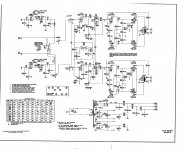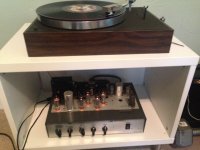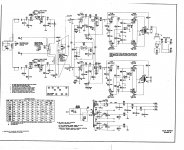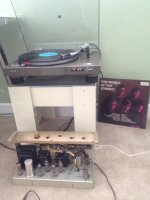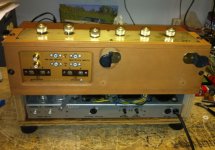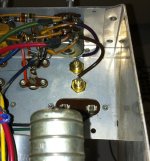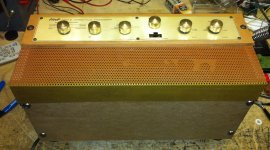Have a look at the schematic for my Pilot 1060M. This is the unit i have powering my office system, which i use for primarily vinyl and occasional ipod use through the aux input.
I have it playing through a small set of Tannoy PBM 6.5 on my desk, and an AR-XA turntable.
I have simplified the original schematic down because it contained provisions for mono / stereo switch ( which i don't need ), aspects for the motor on the turntable it used to accompany, etc. I cleaned these aspects out of it ( though, in my work i see that i never bothered to wire a fuse into the mains! ) I replaced many of the beeswax caps with mustard poly's, and an electrolytic or two that needed it. I remounted the controls from being vertically operated and suspended above the tubes, stuck it in an old Bogen solid state PA amp chassis and mounted the tubes coming out of the top of it. It passes the "wife test" on aesthetics now.
I have a couple questions
1) The output stage... i've never seen the HT supply running right to the screens before. Normally i see it going through the center tap of the OT and then to the plates. What is this type of configuration called?
Would it be better if i bought larger OTs and configured it for UL output? It seems like that or triode mode are the standard setups for hifi application.
2) Are there any improvements i could make to that phono stage in place? Sometimes i debate breaking this thing up and just building it into a killer tube line stage / EL84 PP stereo integrated with a modern circuit, and then building a separate modern design phono stage.... but then i think "this is a pilot! why mess with a classic design?" ...but, it's just a chassis that i've already modified to some extent out of its original turntable / picnic player setup.
3) Finally, the component in the middle of the schematic is part of a 3-way switch that allowed the user to select Phono, Phono with automatic turntable shutoff, and Aux. I can't figure out a way to wire this to get a third input out of it... i may just be stuck with two phono settings and one aux and that's it unless i replace the switch altogether ( which i'm not opposed to ). One of the phono positions switches in some additional electrolytics into the circuit, though... i can't figure out why.
So... what are your thoughts on this thing?
I have it playing through a small set of Tannoy PBM 6.5 on my desk, and an AR-XA turntable.
I have simplified the original schematic down because it contained provisions for mono / stereo switch ( which i don't need ), aspects for the motor on the turntable it used to accompany, etc. I cleaned these aspects out of it ( though, in my work i see that i never bothered to wire a fuse into the mains! ) I replaced many of the beeswax caps with mustard poly's, and an electrolytic or two that needed it. I remounted the controls from being vertically operated and suspended above the tubes, stuck it in an old Bogen solid state PA amp chassis and mounted the tubes coming out of the top of it. It passes the "wife test" on aesthetics now.
I have a couple questions
1) The output stage... i've never seen the HT supply running right to the screens before. Normally i see it going through the center tap of the OT and then to the plates. What is this type of configuration called?
Would it be better if i bought larger OTs and configured it for UL output? It seems like that or triode mode are the standard setups for hifi application.
2) Are there any improvements i could make to that phono stage in place? Sometimes i debate breaking this thing up and just building it into a killer tube line stage / EL84 PP stereo integrated with a modern circuit, and then building a separate modern design phono stage.... but then i think "this is a pilot! why mess with a classic design?" ...but, it's just a chassis that i've already modified to some extent out of its original turntable / picnic player setup.
3) Finally, the component in the middle of the schematic is part of a 3-way switch that allowed the user to select Phono, Phono with automatic turntable shutoff, and Aux. I can't figure out a way to wire this to get a third input out of it... i may just be stuck with two phono settings and one aux and that's it unless i replace the switch altogether ( which i'm not opposed to ). One of the phono positions switches in some additional electrolytics into the circuit, though... i can't figure out why.
So... what are your thoughts on this thing?
Attachments
Last edited:
I've got nothing to add except that I own one of these as well. I'm running it with a tuner and KLH Model Six speakers. I really like the sound of it.
I don't know that Pilot was revered for its phono stages, but I can't imagine that they did a half assed job on them.
I forget why I think this, but somewhere I read or saw that Buddy Holly's label gave one of these units to Holly's wife as a Christmas gift.
I don't know that Pilot was revered for its phono stages, but I can't imagine that they did a half assed job on them.
I forget why I think this, but somewhere I read or saw that Buddy Holly's label gave one of these units to Holly's wife as a Christmas gift.
3) Finally, the component in the middle of the schematic is part of a 3-way switch that allowed the user to select Phono, Phono with automatic turntable shutoff, and Aux. I can't figure out a way to wire this to get a third input out of it... i may just be stuck with two phono settings and one aux and that's it unless i replace the switch altogether ( which i'm not opposed to ). One of the phono positions switches in some additional electrolytics into the circuit, though... i can't figure out why.
I'd bypass the tone controls, and that odd switch with the electrolytics, which might be a rumble filter. It's hard to read that thumbnail, though.
The phono input caps should be of high quality. The HK Citation I preamp used a regular ceramic type on the phono inputs, and suffered because of it.
The RIAA circuit reminds me a little of the old Quad preamp, although that one used a pentode instead of a triode.
Last edited:
This is pentode mode. It will have high output impedance (low DF) but fortunately the negative feedback will improve this.Magnetmaz said:1) The output stage... i've never seen the HT supply running right to the screens before. Normally i see it going through the center tap of the OT and then to the plates. What is this type of configuration called?
The phono pre-amp design is clearly very cost engineered - Pilot was very good at maximizing performance and minimizing cost, there are some very serious tradeoffs here in terms of RIAA accuracy, input loading (not even close to 47K and frequency dependent) and noise. In this case an outboard diy phono pre could be a major upgrade or if you can find the space for an extra tube a variant of the RCA phono stage might be a worthwhile upgrade. (Eli has written extensively about this and has an improved version, search or perhaps he will see this thread and weigh in)
The iron tends to be very good in Pilot products - this is one area where they did not cut corners. FWIW I have never heard a bad sounding tube based Pilot amp or receiver. They were well engineered.
The phase splitter appears to be a variant on the paraphase and is quite similar to what HH Scott used in some of their earlier 299 and other models. (HF balance may be a bit iffy, the cathodyne approach is IMO an improvement and requires no additional tubes)
I suspect you have AC wiring running very close to the existing phono stage based on the rehousing which is imo otherwise cool. I would run the ac wiring through a grounded braid (or shielded tube or similar)
Hope you have a proper three wire power cord and have grounded the chassis for safety. Definitely put a fuse on this thing, and any remaining original electrolytics should be replaced.
The iron tends to be very good in Pilot products - this is one area where they did not cut corners. FWIW I have never heard a bad sounding tube based Pilot amp or receiver. They were well engineered.
The phase splitter appears to be a variant on the paraphase and is quite similar to what HH Scott used in some of their earlier 299 and other models. (HF balance may be a bit iffy, the cathodyne approach is IMO an improvement and requires no additional tubes)
I suspect you have AC wiring running very close to the existing phono stage based on the rehousing which is imo otherwise cool. I would run the ac wiring through a grounded braid (or shielded tube or similar)
Hope you have a proper three wire power cord and have grounded the chassis for safety. Definitely put a fuse on this thing, and any remaining original electrolytics should be replaced.
This is great advice. Thanks to everyone for weighing in on this.
An old Japanese guy recently gave me a Pioneer PL250 turntable and an A-2030 integrated amp. I put those in place of this Pilot rig, and put it down on my bench to start going through it and making improvements.
i had thought about using a more current tube phono stage built into this system to replace the simplistic one mentioned. I'd wager the Tetra phono stage may work?
If i'm keeping it old-school, i could always use the RCA circuit Kevin mentioned.
An old Japanese guy recently gave me a Pioneer PL250 turntable and an A-2030 integrated amp. I put those in place of this Pilot rig, and put it down on my bench to start going through it and making improvements.
i had thought about using a more current tube phono stage built into this system to replace the simplistic one mentioned. I'd wager the Tetra phono stage may work?
If i'm keeping it old-school, i could always use the RCA circuit Kevin mentioned.
Pilot 1060 variants
There are at least 3 variants of the Pilot 1060 with B and C versions in addition to the original. Both B and C differ from the original in controls and inputs. I haven’t compared circuits but assume them to be very similar with minor changes to accommodate the control and input differences. The C version has a mains fuse soldered in place from the factory. All versions can be considered rare and my informal survey shows about one unit appearing on eBay in any given year.
I’m more of a vintage collector and rarely modify vintage gear. I have a 1060-B that is in nice enough condition that I use it occasionally and would never change anything. There is a video of it spinning a tune here - https://www.youtube.com/watch?v=gQyXJON-IWg
I also have a 1060-C that was cosmetically challenged. I removed the electronics from the cabinet and built a smaller cabinet that allows some level of portability to the amp. Improving the phono section would be such a daunting task that I’ve come up with 2 easier solutions. The first is to use an independent phono section into one of the 2 line level inputs. I find the line section with a single triode (1/2 of a 12AX7) for both bass and treble controls to be another sonically weak area. Bypassing the line and phono stages and allowing use as a power amp is quite simple. There is blank area on the input panel to add a pair of RCA jacks. This area is adjacent to the treble pot. There is a length of shielded wire that runs from the wipers of the treble pots to pin 2 on the amp stage’s 12AX7s. A 2 to 3 inch wire is run from the new RCA jacks to the wipers of the treble pot.
The power amp is a solid performer with a simple circuit and good iron. The 2 attached pictures summarize the contents of this post.
There are at least 3 variants of the Pilot 1060 with B and C versions in addition to the original. Both B and C differ from the original in controls and inputs. I haven’t compared circuits but assume them to be very similar with minor changes to accommodate the control and input differences. The C version has a mains fuse soldered in place from the factory. All versions can be considered rare and my informal survey shows about one unit appearing on eBay in any given year.
I’m more of a vintage collector and rarely modify vintage gear. I have a 1060-B that is in nice enough condition that I use it occasionally and would never change anything. There is a video of it spinning a tune here - https://www.youtube.com/watch?v=gQyXJON-IWg
I also have a 1060-C that was cosmetically challenged. I removed the electronics from the cabinet and built a smaller cabinet that allows some level of portability to the amp. Improving the phono section would be such a daunting task that I’ve come up with 2 easier solutions. The first is to use an independent phono section into one of the 2 line level inputs. I find the line section with a single triode (1/2 of a 12AX7) for both bass and treble controls to be another sonically weak area. Bypassing the line and phono stages and allowing use as a power amp is quite simple. There is blank area on the input panel to add a pair of RCA jacks. This area is adjacent to the treble pot. There is a length of shielded wire that runs from the wipers of the treble pots to pin 2 on the amp stage’s 12AX7s. A 2 to 3 inch wire is run from the new RCA jacks to the wipers of the treble pot.
The power amp is a solid performer with a simple circuit and good iron. The 2 attached pictures summarize the contents of this post.
Attachments
- Status
- This old topic is closed. If you want to reopen this topic, contact a moderator using the "Report Post" button.
- Home
- Amplifiers
- Tubes / Valves
- Pilot 1060 integrated - make it better!
